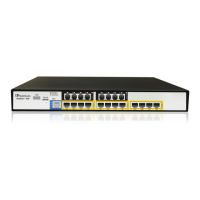16.1.2 Silence Suppression (Compression)
Silence suppression (compression) is a method for conserving bandwidth on VoIP calls by
not sending packets when silence is detected. The device uses its VAD feature to detect
periods of silence in the voice channel during an established call. When silence is
detected, it stops sending packets in the channel.
The procedure below describes how to enable silence suppression using the Web
interface.
To enable silence suppression using the Web interface:
1. Open the Voice Settings page (Configuration tab > VoIP menu > Media submenu >
Voice Settings).
Figure 16-2: Enabling Silence Suppression in Voice Settings Page
2. Set the 'Silence Suppression' (EnableSilenceCompression) field to Enable.
3. Click Submit to apply your changes.
16.1.3 Echo Cancellation
The device supports adaptive linear (line) echo cancellation according to G.168-2002.
Echo cancellation is a mechanism that removes echo from the voice channel. Echoes are
reflections of the transmitted signal.
In this line echo, echoes are generated when two-wire telephone circuits (carrying both
transmitted and received signals on the same wire pair) are converted to a four-wire circuit.
Echoes are reflections of the transmitted signal, which result from impedance mismatch in
the hybrid (bi-directional 2-wire to 4-wire converting device).
An estimated echo signal is built by feeding the decoder output signal to an RLS-like
adaptive filter, which adapts itself to the characteristics of the echo path. The ‘estimated
echo signal’ (the output of this filter) is then subtracted from the input signal (which is the
sum of the desired input signal and the undesired echo) to provide a clean signal. To
suppress the remaining residual echo, a Non Linear Processor (NLP) is used, as well as a
double-talk (two people speak at the same time) detector that prevents false adaptation
during near-end speech.
The device also supports acoustic echo cancellation for SBC calls. These echoes are
composed of undesirable acoustical reflections (non-linear) of the received signal (i.e., from
the speaker) which find their way from multiple reflections such as walls and windows into
the transmitted signal (i.e., microphone). Therefore, the party at the far end hears his / her
echo. The device removes these echoes and sends only the near-end’s desired speech
signal to the network (i.e., to the far-end party). The echo is composed of a linear part and
a nonlinear part. However, in the Acoustic Echo Canceler, a substantial part of the echo is
non-linear echo. To support this feature, the Forced Transcoding feature must be enabled
so that the device uses DSPs.
The procedure below describes how to configure echo cancellation using the Web
interface:

